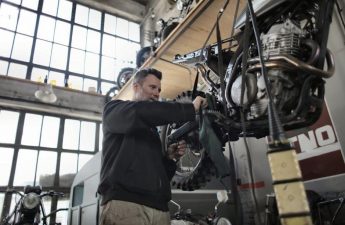Recliner Repair⁚ Common Problems and Solutions
Manual recliners‚ while durable‚ experience common issues like broken springs‚ malfunctioning mechanisms‚ or damaged footrests. Troubleshooting often involves identifying the faulty part – a broken spring‚ a sheared pin‚ or a problem with the handle. Repair may require replacing parts or tightening loose components. Online resources and videos offer guidance for DIY fixes.
Identifying Common Recliner Issues
Manual recliner problems often stem from wear and tear on mechanical parts. A common issue is a broken or weakened recliner spring‚ causing the chair to not recline smoothly or fully. The reclining mechanism itself can malfunction due to bent or broken linkages‚ causing the chair to get stuck or not return to its upright position. Loose or damaged handles are another frequent problem‚ making it difficult or impossible to operate the recliner. Careful inspection of the recliner’s handle‚ springs‚ and linkages is crucial for diagnosis. Pay close attention to any unusual sounds or resistance during operation; these may indicate a problem with the mechanism. Examine the footrest for any signs of damage or looseness as well. A thorough visual inspection will help pinpoint the source of the malfunction before attempting any repairs.
Troubleshooting Recliner Mechanisms
Troubleshooting a manual recliner mechanism begins with careful observation. Listen for unusual sounds like grinding or clicking during operation; these often pinpoint a specific problem area. Check for any visible damage to the linkage components‚ including bent or broken parts. If the recliner gets stuck in a certain position‚ gently try to move the mechanism by hand to identify binding points or obstructions. Look for any loose screws or bolts that might need tightening. A common problem is a dislodged or broken spring; this often requires replacing the spring. Examine the handle and its connection to the mechanism for any signs of wear or damage. If the problem persists after checking these components‚ a more detailed inspection may be necessary‚ possibly requiring partial disassembly of the mechanism to locate the source of the malfunction. Remember safety precautions when disassembling and troubleshooting.
Repairing Broken Recliner Springs
Broken recliner springs are a frequent cause of malfunction; Identifying the broken spring often requires partially disassembling the recliner mechanism‚ carefully noting the arrangement of parts before removal. Replacing a broken spring necessitates obtaining a replacement spring of the correct size and tension. This may require measuring the old spring or referring to the recliner’s manufacturer’s specifications or diagrams. If replacing the spring yourself‚ use appropriate tools such as pliers or spring compressors to safely install the new spring‚ ensuring it’s correctly positioned and aligned within the mechanism. Improper installation can lead to further damage or injury. If unsure about any aspect of the repair‚ seeking professional assistance is recommended. Improperly installed springs can compromise the structural integrity of the recliner‚ potentially leading to safety hazards. Always prioritize safety when handling springs and working with the recliner mechanism.
Fixing a Recliner Footrest
A malfunctioning recliner footrest can significantly impact comfort and usability. Common problems include a footrest that won’t extend fully‚ retracts unexpectedly‚ or is stuck in one position. Troubleshooting begins with a visual inspection‚ checking for any visible damage to the footrest mechanism‚ such as bent or broken components‚ loose screws or rivets‚ or frayed cables. Many footrest issues stem from problems with the connecting levers‚ springs‚ or cables. Repair may involve tightening loose fasteners‚ replacing broken parts‚ or lubricating stiff joints with an appropriate lubricant. Accessing the mechanism often requires partially disassembling the recliner‚ so carefully observe the assembly process before beginning any repairs to aid reassembly. If the problem persists after attempting these fixes‚ professional repair services may be necessary to avoid further damage or injury. Remember‚ safety should always be prioritized when working with the recliner’s mechanics.
DIY Recliner Repair⁚ Tools and Techniques
Successfully repairing a manual recliner often requires basic hand tools⁚ screwdrivers (Phillips and flathead)‚ pliers‚ wrenches‚ and possibly a drill with drill bits. Careful observation and methodical disassembly are crucial for successful repair and reassembly.
Essential Tools for Recliner Repair
Tackling manual recliner repair necessitates a well-equipped toolbox. A sturdy Phillips head screwdriver is essential for removing and replacing screws securing various components. A flathead screwdriver proves useful for prying open stubborn parts or adjusting tight mechanisms; Needle-nose pliers offer precision for handling small parts and wires‚ while adjustable pliers provide extra grip for larger components. Wrenches‚ both open-ended and socket types‚ are critical for loosening and tightening bolts and nuts‚ especially within the recliner’s mechanism. A hammer may be needed for carefully tapping parts into place or removing stubborn rivets (though replacing rivets with bolts is often preferred). Safety glasses are crucial to protect your eyes from flying debris or springs. Finally‚ a flashlight can illuminate dark corners and recessed areas‚ allowing for a clear view of internal components during the repair process. Having these tools readily available will streamline the repair process and increase the chances of success.
Step-by-Step Guide to Recliner Repair
Before starting any repair‚ carefully examine the recliner to pinpoint the problem. Take photos to aid in reassembly. If a spring is broken‚ access it by removing the relevant fabric panels (use caution to avoid tearing). Replace the spring with an identical one‚ ensuring correct positioning. For a malfunctioning mechanism‚ check for bent or broken parts; replacement may be necessary. If the footrest is the issue‚ inspect the linkage and cables for damage; repair or replace as needed. When working with the recliner’s mechanism‚ carefully note the position of each component before disassembling. Replacing parts often involves reversing the disassembly steps. Clean any debris or dust during the process to ensure smooth operation. Always use the appropriate tools (screwdrivers‚ pliers‚ wrenches) to prevent damage. Once the repair is complete‚ test the recliner thoroughly to ensure functionality. If unsure about any step‚ consult online videos or manuals for guidance. Remember safety first!
Replacing Recliner Handles
Loose or broken recliner handles are a common issue‚ often easily remedied. Begin by assessing the handle’s attachment; is it screwed‚ riveted‚ or glued? For screw-attached handles‚ use a screwdriver to remove the screws. If the handle is riveted‚ carefully drill out the rivets; this requires precision to avoid damaging surrounding components. Once the old handle is removed‚ compare it to a replacement handle from a furniture parts supplier or online retailer to ensure compatibility; If the new handle is a direct replacement‚ simply reverse the removal process‚ securing it with screws or rivets. Should the new handle differ slightly‚ you may need to adjust the mounting holes or use additional fasteners. For glued handles‚ carefully separate the handle using a putty knife or similar tool‚ ensuring not to damage the underlying material. After cleaning the area‚ apply a strong adhesive‚ such as epoxy‚ and secure the new handle in place. Allow the adhesive to cure completely before using the recliner. Remember to take photos of the process for reference.
Repairing Recliner Cables
Recliner cables‚ crucial for smooth operation‚ can fray‚ break‚ or become detached‚ hindering the reclining function. Before starting‚ inspect the entire cable system for damage. A visual inspection might reveal frayed areas‚ broken strands‚ or loose connections at the handle or mechanism. If a cable is simply detached‚ reattaching it might solve the problem. This often involves carefully aligning the cable end with the appropriate attachment point and securing it. For frayed or broken cables‚ replacement is necessary. Measure the length of the damaged cable to purchase a suitable replacement. When replacing‚ carefully route the new cable through the recliner’s internal pathways‚ mimicking the original cable’s path. Ensure the cable is taut but not overly stretched to avoid future issues. Secure the cable ends firmly at both the handle and the reclining mechanism. Lubricating the cable mechanism with a suitable lubricant‚ like silicone spray‚ can enhance smooth operation. Test the recliner thoroughly after repairs to ensure proper functionality and smooth reclining action. Remember safety precautions when working with sharp objects.
Finding Professional Recliner Repair
Professional recliner repair services offer expertise for complex issues. Locating reputable technicians involves online searches‚ referrals‚ or checking local classifieds. Consider experience‚ reviews‚ and cost estimates before choosing a service. Professional repairs ensure lasting solutions.
Locating Local Recliner Repair Services
Finding skilled local recliner repair services can significantly ease the burden of fixing your manual recliner. Start by utilizing online search engines‚ inputting keywords like “manual recliner repair near me” or “local upholstery services.” Online directories often list businesses with customer reviews‚ allowing you to gauge their reputation and reliability before making contact. Check for ratings and testimonials to assess the quality of their previous work and customer satisfaction. Consider reaching out to furniture stores; they may have recommendations or even offer repair services themselves. Don’t underestimate the power of word-of-mouth; ask friends‚ family‚ or neighbors for referrals to trustworthy local businesses with proven experience in manual recliner repair. Remember to compare quotes from multiple services before making a decision to ensure you’re getting a fair price for the job. This thorough approach will help you locate a qualified professional to restore your recliner to its former glory.
Choosing a Reputable Recliner Repair Technician
Selecting a trustworthy recliner repair technician is crucial for a successful repair. Thoroughly vet potential technicians before entrusting your valuable recliner to them. Start by checking online reviews and ratings on platforms like Google My Business‚ Yelp‚ or other relevant review sites. Look for consistent positive feedback regarding their professionalism‚ expertise‚ and the quality of their workmanship. Inquire about their experience specifically with manual recliner mechanisms; experience with this type of repair is essential. Don’t hesitate to ask for references from previous clients; speaking with satisfied customers can provide valuable insights into their work ethic and reliability. A reputable technician will provide a detailed estimate upfront‚ clearly outlining the costs of parts and labor. Avoid technicians who are vague about pricing or seem overly eager to begin work without a thorough assessment. Verify their licensing and insurance to ensure they’re operating legally and protect you from potential liabilities. A well-chosen technician ensures your manual recliner is repaired correctly and efficiently‚ extending its lifespan.
Understanding Recliner Repair Costs
The cost of repairing a manual recliner varies significantly depending on several factors. The complexity of the repair plays a crucial role; a simple fix like replacing a broken handle will be far less expensive than repairing a severely damaged reclining mechanism. The cost of parts is another major determinant. Replacement parts‚ especially for older or less common recliner models‚ can be expensive. Labor costs also contribute significantly to the overall expense. The technician’s experience and hourly rate will directly impact the final price. Geographical location also influences costs; repair services in densely populated areas tend to charge higher rates compared to those in rural regions. Before committing to a repair‚ obtain multiple quotes from different technicians to compare pricing and services. A detailed breakdown of costs‚ including parts and labor‚ should be provided upfront. Be wary of unusually low quotes‚ as this may indicate a lack of quality or hidden charges. Understanding these factors helps in budgeting for the repair and ensures a transparent and fair transaction. Remember to factor in potential additional costs that may arise during the repair process.


